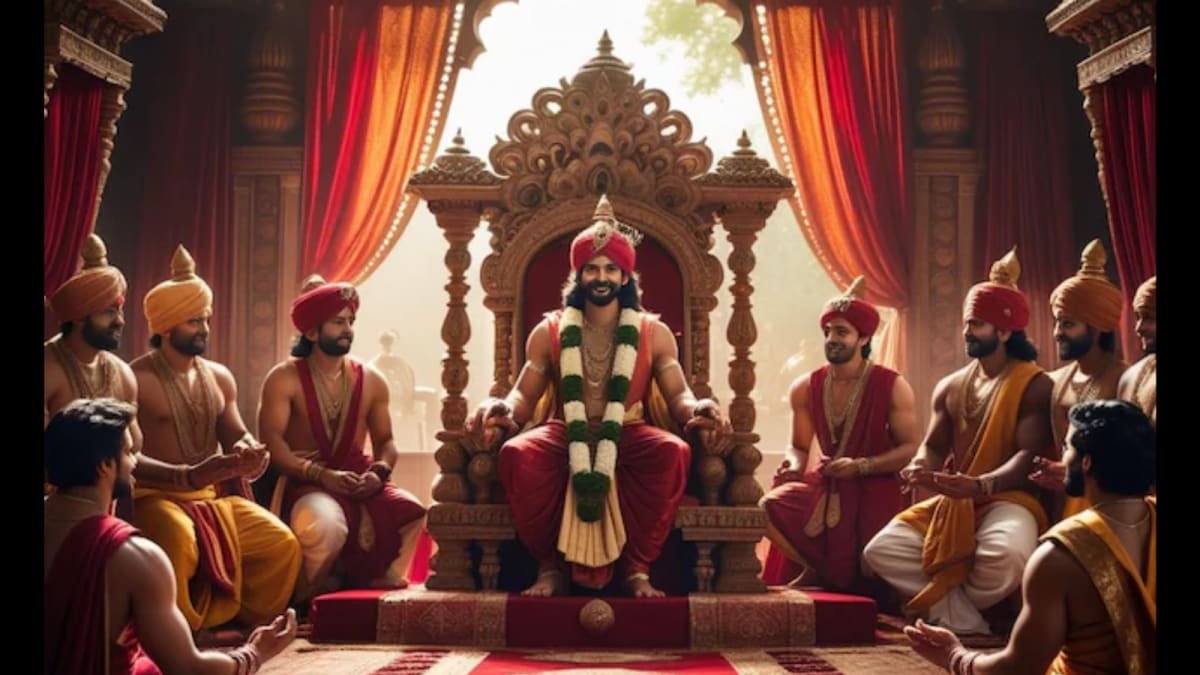Last Updated:July 04, 2025, 12:52 IST
After the Mahabharata war, Yudhishthir became king of Hastinapur, appointed his brothers as ministers, and ruled for 36 years with justice, reforms, and equal rights for all
Yudhishthir’s rule is remembered for justice and righteousness, as he led with integrity and upheld dharma. (News18 Hindi)
Before the Mahabharata war, Dhritarashtra ruled Hastinapur, while his son Duryodhan held the position of crown prince. The Mahabharata war, a monumental battle described in ancient Indian epic literature, shifted the landscape of power and governance in Hastinapur. Although Vidur was the chief advisor, Duryodhan often overruled his decisions. After the war, significant changes took place. Yudhishthir ascended the throne, and among his first actions was appointing a crown prince and establishing ministries to restore the kingdom.
Reluctance and Coronation
The Mahabharata war spanned 18 days, resulting in the death of numerous soldiers and great warriors from both sides. Initially, Yudhishthir was overwhelmed with grief and hesitant to accept the throne. However, with the encouragement of Krishna, Bhishma, and his brothers, he eventually agreed.
Bhishma Pitamah, from his bed of arrows, imparted profound knowledge of Rajdharma to Yudhishthir, urging him to govern with balance and wisdom.
Once convinced, Yudhishthir was crowned king of Hastinapur. His reign lasted 36 years, marked by fairness and righteousness. After his rule, he handed over the kingdom to his grandson, Parikshit, and embarked on a journey to the Himalayas with his brothers to renounce worldly life.
Lives Lost During Mahabharata
The Mahabharata war involved 18 Akshohini armies – 11 from the Kauravas and 7 from the Pandavas. An Akshohini is an ancient military unit consisting of:
21,870 infantry
21,870 horsemen
21,870 chariots
21,870 elephants
Each Akshohini comprised approximately 109,350 warriors. Only 18 warriors survived the war, a staggering loss that deeply affected Yudhishthir.
The Coronation Ceremony
Yudhishthir’s coronation was a grand traditional event. He sat on a golden throne, flanked by Bhima and Arjuna. Krishna and Satyaki stood before him, while Kunti, Nakul, and Sahadev were seated nearby. Conches were blown, drums resounded, and sacred rituals were conducted. Yudhishthir made generous donations to Brahmins and commenced his reign.
Who Got What Role
Yudhishthir established a structured administration with clearly defined roles:
Bhima: Crown prince and Home Minister.
Vidur: In charge of diplomacy and state counsel.
Sanjaya: Managed revenue and expenditure, akin to a Finance Minister.
Nakul: Appointed Defence Minister, overseeing the army.
Arjuna: Handled external threats and upheld law, similar to a Foreign and Law Minister, and led the army during wars.
Sahadev: Responsible for the king’s personal protection.
Dhoumya (Priest): Entrusted with religious rites and service to the gods and Brahmins.
Care for Dhritarashtra and Distribution of Palaces
Vidur, Sanjaya, and Yuyutsu continued to assist Dhritarashtra. With his approval, Yudhishthir distributed the palaces of the fallen Kaurava brothers to his siblings—Bhima received Duryodhan’s house, Arjuna got Dushasan’s, Nakul was given Durmarshan’s, and Sahadev received Durmukh’s palace.
Yudhishthir’s Legacy as a Ruler
He vowed to rule honestly, treating all subjects with love and fairness. His also uplifted all societal sections, ensuring equality across castes and communities. He supported scholars and Brahmins, fostering education and learning. Yudhishthir’s era remains a model of just and moral governance, rooted in duty, discipline, and devotion.
- First Published:
#Mahabharata #Stories #Yudhishthir #King #Crown #Prince #Hastinapur #Lifestyle #News





